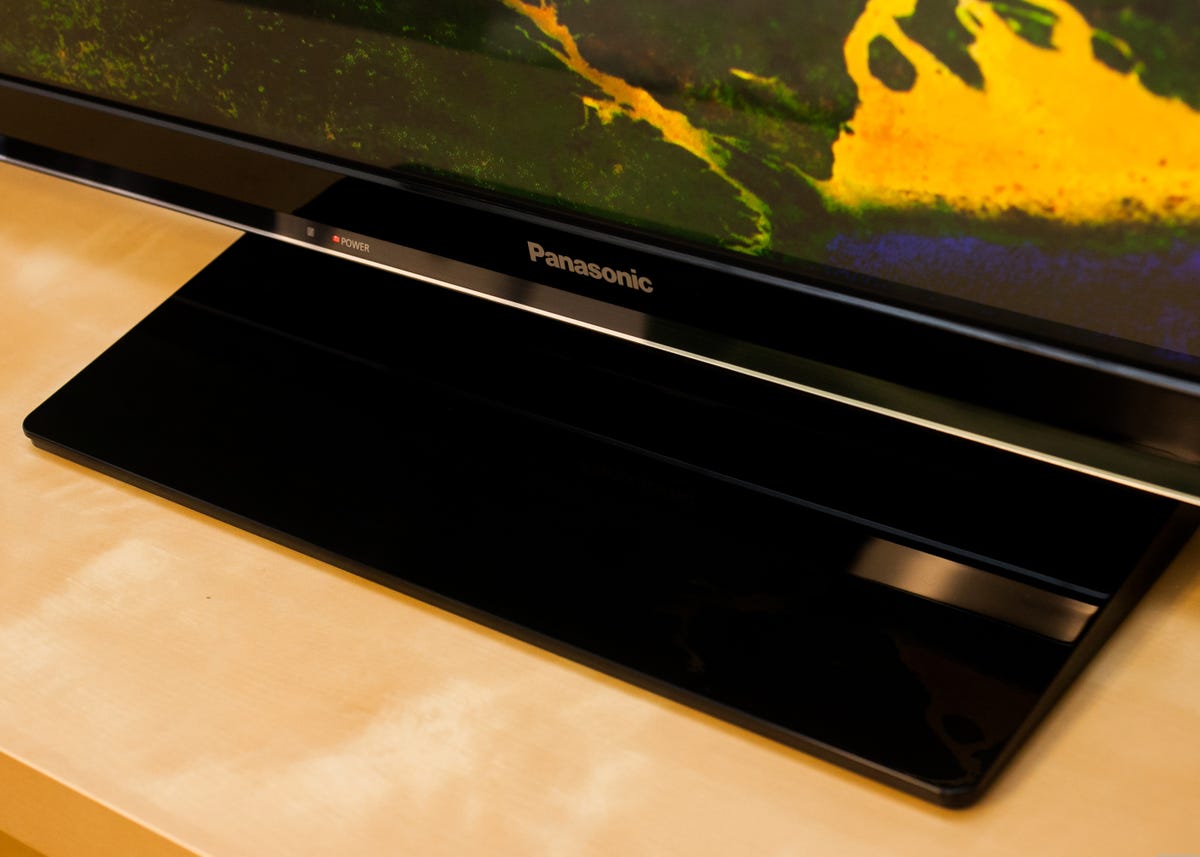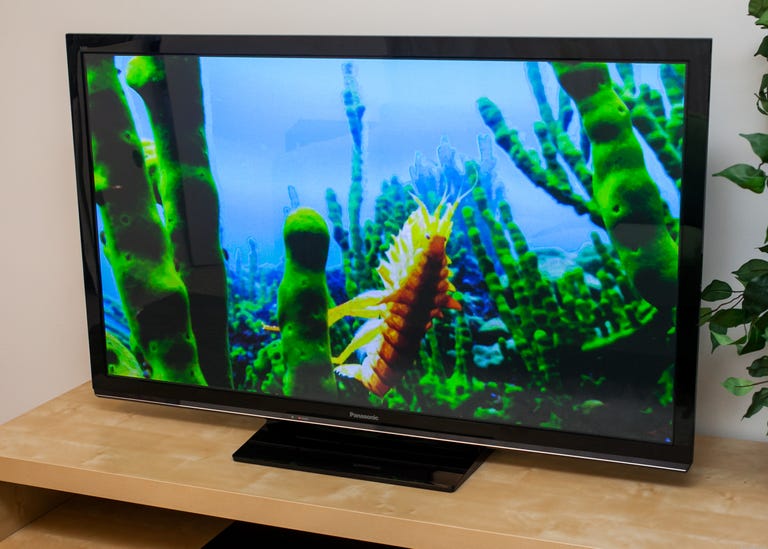 Why You Can Trust CNET
Why You Can Trust CNET Panasonic TC-PU50 review: Panasonic TC-PU50
The Panasonic TC-P50U50 lacks Smart TV, 3D, and other bells and whistles, but a low price and excellent picture quality make it an outstanding value.
In a year when dual-core TVs vaunt voice control, touch-pad remotes, gesture recognition, app stores, and often mediocre picture quality, the Panasonic TC-PU50 series is a throwback. A bona fide Dumb TV, the U50 couldn't launch an app or sync with 3D glasses to save its life. If you're like me and consider those extras largely unnecessary in a television, you'll find a lot to like here.
The Good
The Bad
The Bottom Line
No, Panasonic's cheapest 1080p plasma TV can't match the picture quality of its more expensive linemates, but it trounces any TV I've seen in its price range. Exceedingly deep black levels and accurate color, along with plasma's hallmark perfect uniformity and off-angle viewing, combine for 2D bliss in medium-dark to dark rooms.
It doesn't do as well with the lights turned up, however, so if you can spare the money, or want more choices in size, you should consider stepping up to something like the ST50. But if you just want the best no-frills plasma TV for the best price, look no further.
Editors' Note: Originally Panasonic offered only one screen size, 50 inches, but the company has since added a second at 60 inches. This review had been modified to reflect that addition.
Series information: I performed a hands-on evaluation of the 50-inch Panasonic TC-P50U50, but this review also applies to the 60-inch size in the series. Both have identical specs and according to the manufacturer should provide very similar picture quality.| Models in series (details) | ||||
| Panasonic TC-P50U50 (reviewed) | 50 inches | |||
| Panasonic TC-P60U50 | 60 inches | |||
Design
Nothing to see here. The no-nonsense TC-PU50 series comes one uniform color: basic glossy black. The frame around the screen is medium-thick and the same width on all sides, with a subtle bottom lip and a thin accent strip of silver. The glossy black pedestal stand is low-profile and does not swivel.
The remote is similarly basic, with button groups that are well-differentiated by size and placement if not color. There's no backlighting. I liked the clicker well enough, although the volume and channel keys seem a bit large relative to the cursor control. I also noticed that the menus, spare and functional, loaded slightly more sluggishly than on the TC-P50UT50 -- but you'll use them infrequently, so it hardly matters.

| Key TV features | ||||
| Display technology | Plasma | LED backlight | N/A | |
| Screen finish | Glossy | Remote | Standard | |
| Smart TV | Yes, No | Internet connection | Wired, Built-in Wi-Fi | |
| 3D technology | N/A | 3D glasses included | N/A | |
| Refresh rate(s) | 60Hz, 48Hz | Dejudder (smooth) processing | Yes, No | |
| DLNA-compliant | No | USB | Photo/Music/Video | |
Features
I could spend a lot of time enumerating the many options this TV doesn't have, but it's easier to list its few features. The main one is 1080p resolution, which accounts for the fact that its price is almost identical to that of the Smart TV- and 3D-compatible, yet only 720p, TC-P50XT50. Resolution also appears to be the main
difference between the U50 and the even-cheaper 720p TC-PX5
series.
The more expensive UT50 includes Smart TV, 3D, 1080p resolution, and dejudder (smoothing) among its main step-ups above the U50 being reviewed here, as well as a couple of relatively minor picture quality advantages (see below).
Worth noting at this price level is the SD card slot, which makes it easy to view photos from digital cameras on the big screen (Panasonic is the only TV maker to commonly include such a slot). You can also play music and videos loaded on an SD card, and the USB port can handle music, photos, and videos too.
Picture settings: Even the sparsest picture-settings suites from LG and Samsung go beyond what the U50 has. It lacks even a 2-point grayscale control and offers just the basics for everything else. There is a token 48Hz mode for 1080p/24 Blu-rays, but it causes flicker so it's basically useless.
Connectivity: Perhaps this TV's Achilles heel is its lonely pair of HDMI jacks. If you have more than two HDMI sources, for example a cable box, game console, and anything else, you may want to consider another TV. Or you could pair the U50 with an HDMI switch (they're cheap) or AV receiver -- it's a bit more of a hassle, but using a good universal remote can make the experience seamless.
Additional jacks of note are one component-video/composite video input, one USB port, and one SD card slot.
| Comparison models (details) | ||||
| Panasonic TC-P50UT50 | 50-inch plasma | |||
| Samsung PN51E550 | 51-inch plasma | |||
| LG 50PM9700 | 50-inch plasma | |||
| Toshiba 50L5200U | 50-inch LED | |||
| Vizio M3D550KD | 55-inch LED | |||
Picture quality
In a word, "Excellent." The U50 earned the same subrating of 8 we awarded to its step-up brother the UT50, putting it in rarefied company no other TV in its price range can approach. Color and black levels were as good as the UT50's, although its video processing and bright-room picture were worse. Those two issues provide very good reasons to invest in models like the Panasonic TC-P55ST50 or Samsung PN60E6500 plasmas or, for the plasma-averse, one of the better LEDs.
Click the image at the right to see the picture settings used in the review and to read more about how this TV's picture controls worked during calibration.
Black level: The entry-level U50 is capable of producing as deep a shade of black as any Panasonic plasma we've tested, with the exception of the flagship TC-P65VT50. Its inky-black chops were immediately apparent in the opening sequence from "Tree of Life"; the blackness surrounding the orange illumination was as dark as that of the UT50, and darker than any other TV in the lineup managed, including the Vizio and the Samsung E550. The breathtaking spacescapes at the beginning of chapter 4 provided another example, where the blackness of the void on the two Panasonics made the images pop as on none of the others.
Although the U50 and UT50 couldn't quite match the light output of the other sets in our measurements, the difference was almost impossible to spot in most program material. In brighter areas, like the sheets, shades, and white walls in Jack's bedroom and house (chapter 3), they weren't any dimmer than on the other TVs, either to my eye or to my handheld light meter. Only when the screen turned mostly white, such as when the camera follows Jack's wife upstairs and a white wall occludes a good portion of the screen (12:44) or during a shot of mostly white sky (13:27) did the U50 get dimmer than the Samsung -- and even then the difference was very subtle.
The Panasonics' shadow detail was very good, surpassing the others in the lineup. The face of Mrs. O'Brien kissing young Jack in bed (48:23) had plenty of definition and no murkiness, for example, while the other sets, especially the LEDs, obscured these areas somewhat.
Color accuracy: Despite lackluster grayscale measurements the color of the U50 looked quite good in person, with excellent balance and no "push" toward one primary color or another. The delicate skin tones of Mrs. O'Brien (8:08) looked natural, if a bit too pale and reddish-green compared with the Samsung's. Its saturation, as evinced by the grass in the yard for example, was also slightly less rich than either the Samsung or the Vizio, but still very good. The U50 and UT50 showed almost identical color to my eye.
As with other Panasonic plasmas I also appreciated that black and near-black areas remained neutral and didn't veer into blue or green, like the LEDs in particular did.
Video processing: Unlike the UT50, the U50 couldn't properly reproduce 1080p/24 film cadence when set to its standard (60Hz) mode. Instead, the pan over the Intrepid from "I Am Legend" (my standard cadence test) appeared halting and choppy. I tried the 48Hz mode but as usual it flickered too much for me to tolerate, albeit a bit less than the UT50's 48Hz mode, for some reason.
The U50 lacks a smoothing dejudder mode, which is no great loss in my book, but that means it couldn't match the maximum motion resolution of the UT50 in our tests. No matter -- program material was as blur-free as ever to my eyes.
Bright lighting: The U50's picture quality takes a downward turn as room lighting gets brighter, and is one of the worst TVs we've seen this year at combating ambient lighting. Its screen finish looks gray under moderate lighting, and as a result the image washes out to an even larger extent than the UT50's. It doesn't help that both plasmas can't be "turned up" bright enough to really compensate, nor that both created bright reflections of in-room objects.
The Samsung's screen finish wasn't any better than the U50's, although its post-calibration image was brighter, so that helps. The LG, Vizio, and Toshiba all were significantly better at both preserving black levels and rejecting reflections.
Power consumption: The TC-P50U50 uses about as much juice as its 50-inch plasma brethren, which is more than three times what a typical 55-inch LED TV needs. As usual its Standard picture mode is vanishingly dim, which accounts for the relatively low default power usage. That low default power use is also the reason this TV qualifies for Energy Star 5.3, while 55-inch and larger plasmas do not.
| Geek box: Test | Result | Score |
|---|---|---|
| Black luminance (0%) | 0.0031 | Good |
| Avg. gamma | 2.028 | Average |
| Near-black x/y (5%) | 0.3096/0.3351 | Good |
| Dark gray x/y (20%) | 0.3087/0.3294 | Average |
| Bright gray x/y (70%) | 0.3184/0.3325 | Poor |
| Before avg. color temp. | 6281 | Poor |
| After avg. color temp. | 6141 | Poor |
| Red lum. error (de94_L) | 0.9902 | Good |
| Green lum. error (de94_L) | 0.5101 | Good |
| Blue lum. error (de94_L) | 2.3292 | Average |
| Cyan hue x/y | 0.2283/0.331 | Good |
| Magenta hue x/y | 0.325/0.1583 | Good |
| Yellow hue x/y | 0.4245/0.5109 | Good |
| 1080p/24 Cadence (IAL) | Pass | Good |
| 1080i Deinterlacing (film) | Pass | Good |
| Motion resolution (max) | 750 | Average |
| Motion resolution (dejudder off) | 750 | Average |
| Panasonic TC-P50U50 | Picture settings | ||
| Default | Calibrated | Power save | |
| Picture on (watts) | 125.68 | 208.27 | N/A |
| Picture on (watts/sq. inch) | 0.12 | 0.19 | N/A |
| Standby (watts) | 0.12 | 0.12 | N/A |
| Cost per year | $27.65 | $45.75 | N/A |
| Score (considering size) | Poor | ||
| Score (overall) | Poor | ||



